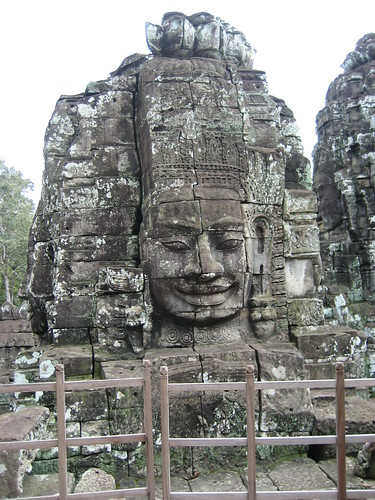

Cambodia 5 Riels 1972 UNC
Front: Bayon Temple tower with the four faces of Avalokitesvara Bodhisattva
Back: The "Prasat Chan Chaya" square is depicted to the right and centre.
 The Chan Chhaya Pavilion, view from the gardens
The Chan Chhaya Pavilion, view from the gardensThe Preah Thineang Chan Chhaya ("Moonlight Pavilion"), is an open-air pavilion that serves as stage for Khmer classical dance in the past and present. It is one of the most notable buildings of the palace as it easily seen from the outside as it was built alongside a section of the palace walls. The Chan Chhaya Pavilion has a balcony that was used as a platform for viewing parades marching along Sothearos Boulevard of Phnom Penh.
Information and Image Obtained From Wikipedia, the free encyclopedia
 Image Obtained from By Eelin's 5th eye on Flickr
Image Obtained from By Eelin's 5th eye on FlickrThe Bayon was the last state temple to be built at Angkor, and the only Angkorian state temple to be built primarily as a Mahayana Buddhist shrine dedicated to the Buddha, though a great number of minor and local deities were also encompassed as representatives of the various districts and cities of the realm. It was the centrepiece of Jayavarman VII's massive program of monumental construction and public works, which was also responsible for the walls and naga-bridges of Angkor Thom and the temples of Preah Khan, Ta Prohm and Banteay Kdei.
The similarity of the 216 gigantic faces on the temple's towers to other statues of the king has led many scholars to the conclusion that the faces are representations of Jayavarman VII himself. Others have said that the faces belong to the bodhisattva of compassion called Avalokitesvara or Lokesvara.[5] The two hypotheses need not be regarded as mutually exclusive. Angkor scholar George Coedès has theorized that Jayavarman stood squarely in the tradition of the Khmer monarchs in thinking of himself as a "devaraja" (god-king), the salient difference being that while his predecessors were Hindus and regarded themselves as consubstantial with Shiva and his symbol the lingam, Jayavarman as a Buddhist identified himself with the Buddha and the bodhisattva.
Information Obtained From Wikipedia, the free encyclopedia
No comments:
Post a Comment